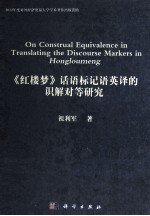

《红楼梦》话语标记语英译的识解对等研究PDF电子书下载
- 电子书积分:11 积分如何计算积分?
- 作 者:祖利军著
- 出 版 社:北京:科学出版社
- 出版年份:2012
- ISBN:9787030348500
- 页数:259 页
Chapter 1 Introduction 1
Chapter 2 Defining and Classifying DMs 14
2.1 DMs in English and Chinese 14
2.2 Functional diversity of DMs 22
2.3 Classification of DMs 27
2.4 Instantiating the pragmatic functions of DMs in Hongloumeng 30
2.4.1 Opinion-indicating 31
2.4.2 Deduction-eliciting 32
2.4.3 Evidence-quoting 33
2.4.4 Topic-initiating 34
2.4.5 Fact-revealing 35
2.4.6 Cause-and-effect identifying 35
2.5 Summary 37
Chapter 3 Toward a Working Translation Critierion:Construal Equivalence 38
3.1 Traditional translation criteria 39
3.1.1 Traditional Chinese translation criteria:fidelity based on aesthetics 39
3.1.2 Traditional western translation criteria:equivalence based on linguistics 44
3.2 Toward a working translation criterion:construal equivalence 58
3.2.1 Relationship between cognitive semantics and translation 58
3.2.2 Definition of construal 60
3.2.3 A working translation criterion:construal equivalence 67
3.3 Factors affecting construal equivalence 70
3.3.1 Linguistic factors 71
3.3.2 The translator's manipulation 74
3.4 Significance of translation equivalence 79
3.5 Summary 82
Chapter 4 Strategies in Relation to Perspective-based Equivalence 84
4.1 Shifts in narrative points of view 86
4.2 Synesthetic shifts 94
4.3 Shifts between human senses and mental processes 98
4.4 Shifts between human senses and other processes 111
4.5 Shifts between mental processes 115
4.6 Shifts from generality to concreteness 120
4.7 Syntactic shifts 125
4.8 Summary 133
Chapter 5 Strategies in Relation to Prominence-based Equivalence 134
5.1 Transposition 135
5.2 Literal translation 138
5.3 Transmigration 143
5.4 Structural parallelism 147
5.5 Summary 152
Chapter 6 Strategies in Relation to Background-based and Specificity-based Equivalence 153
6.1 Domestication 155
6.2 Foreignization 162
6.3 Holism 164
6.4 Summary 168
Chapter 7 Implications and Future Perspectives 171
References 178
Appendixes 189
Appendix A Translation of Opinion-indicators 189
Appendix B Translation of Deduction-elicitors 216
Appendix C Translation of Evidence Quoters 227
Appendix D Translation of Topicalizers 235
Appendix E Translation of Fact-revealers 239
Appendix F Translation of Cause-and-effect Identifiers 246
- 《王蒙文集 新版 35 评点《红楼梦》 上》王蒙著 2020
- 《红色旅游的社会效应研究》吴春焕著 2019
- 《汉语词汇知识与习得研究》邢红兵主编 2019
- 《生物质甘油共气化制氢基础研究》赵丽霞 2019
- 《东北民歌文化研究及艺术探析》(中国)杨清波 2019
- 《联吡啶基钌光敏染料的结构与性能的理论研究》李明霞 2019
- 《异质性条件下技术创新最优市场结构研究 以中国高技术产业为例》千慧雄 2019
- 《《国语》和《战国策》词汇比较研究》陈长书著 2017
- 《中国制造业绿色供应链发展研究报告》中国电子信息产业发展研究院 2019
- 《行政保留研究》门中敬著 2019
- 《中风偏瘫 脑萎缩 痴呆 最新治疗原则与方法》孙作东著 2004
- 《水面舰艇编队作战运筹分析》谭安胜著 2009
- 《王蒙文集 新版 35 评点《红楼梦》 上》王蒙著 2020
- 《TED说话的力量 世界优秀演讲者的口才秘诀》(坦桑)阿卡什·P.卡里亚著 2019
- 《燕堂夜话》蒋忠和著 2019
- 《经久》静水边著 2019
- 《魔法销售台词》(美)埃尔默·惠勒著 2019
- 《微表情密码》(波)卡西亚·韦佐夫斯基,(波)帕特里克·韦佐夫斯基著 2019
- 《看书琐记与作文秘诀》鲁迅著 2019
- 《酒国》莫言著 2019
- 《指向核心素养 北京十一学校名师教学设计 英语 七年级 上 配人教版》周志英总主编 2019
- 《《走近科学》精选丛书 中国UFO悬案调查》郭之文 2019
- 《北京生态环境保护》《北京环境保护丛书》编委会编著 2018
- 《中医骨伤科学》赵文海,张俐,温建民著 2017
- 《美国小学分级阅读 二级D 地球科学&物质科学》本书编委会 2016
- 《指向核心素养 北京十一学校名师教学设计 英语 九年级 上 配人教版》周志英总主编 2019
- 《强磁场下的基础科学问题》中国科学院编 2020
- 《小牛顿科学故事馆 进化论的故事》小牛顿科学教育公司编辑团队 2018
- 《小牛顿科学故事馆 医学的故事》小牛顿科学教育公司编辑团队 2018
- 《高等院校旅游专业系列教材 旅游企业岗位培训系列教材 新编北京导游英语》杨昆,鄢莉,谭明华 2019
